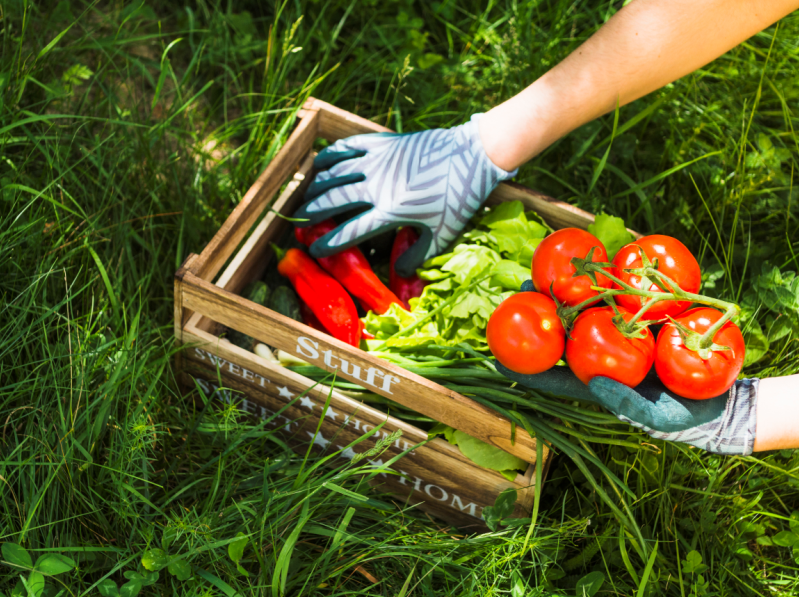
Welcome to the wonderful and rewarding world of vegetable gardening!
If you’re reading this, you’re searching for knowledge on how to start a vegetable garden, and you’ve come to the right place.
This article will give you a wealth of information, plus tips and tricks that will enable you to become a successful gardener in just one growing season.
Gardening is a continuous learning experience and you have to start somewhere, so let’s get started.
Select the Right Location
A sunny location is needed for healthy plant growth. Most plants require a minimum of 6 hours of full sun every day but more sun is better.
Observe the way the sun shines on the garden location you have in mind to determine how many hours of sun the spot receives and if there are any shady spots within the location.
Vegetable plants that need the most sun, like tomatoes, can be planted in full sun areas, and plants that will tolerate a little shade, like radishes, can be planted in partially shaded areas.
The location for your garden doesn’t have to be in-ground - it can be the side of a fence or building for a vertical garden or a balcony or rooftop for a container garden. Whatever type of garden you plan to grow, select a sunny location.
Prepare the Soil
Soil feeds the vegetable plants and it must be fertile so it can do the job. Whether you are creating a vegetable garden in-ground, in raised beds, or containers, the soil must be prepared with nutrients so it can support plant life.
In-ground or raised bed soil must be worked and loosened so tender roots can grow deep. Work the soil with a roto-tiller, turning fork, spade or whatever favorite tool you have in the tool shed. Work the soil to the depth of 12-18 inches, then add 4 inches of compost and light work that into the soil. The loosened soil allows deep root growth, promotes water drainage and air circulation. The compost feeds the soil, promotes microbial activity below soil level and prevents soil compaction.
When growing vegetable plants in containers, select containers that are at least 6 inches deep for most vegetables and herbs. Root vegetables and tomatoes will need to be grown in containers that at least 12 inches deep.
Use a growing medium in containers that contain compost or create a mix that is three-fourths potting soil and one-fourth compost to use in containers.
Sprinkle Epsom salt on top of the soil (1 cup for every 5 square feet of garden space) and lightly rake it into the soil. Water soil well and allow it to sit for 3-5 days before planting your vegetable garden. Epsom salt promotes root growth and will help the vegetable plants develop a strong root system.

Selecting Plants for Your Vegetable Garden
Selecting the right plants for your garden is essential for success. Growing plants that are well adapted to your climate and your garden will provide you with a bigger harvest.
If you live in a climate with a short summer, select plants that mature quickly. Plants that are drought tolerant will be needed for if you live in a climate with long, hot, dry summer. Match the plant with the environment and container in which it will be growing for the best results.
For example, gutter gardening is growing in popularity among urban gardeners that have little to no outdoor space. Normal house guttering can be transformed into a thriving vegetable garden growing on the side of a fence, balcony railing or exterior wall.
The guttering is attached to an outdoor structure, filled with fertile growing medium and produce bountifully - if you select the right plants to grow in the gutter garden.
Because guttering is shallow, only plants with shallow roots can be grown in them. Lettuce, herbs, strawberries, radishes, globe carrots, spinach, chives, and garlic are just some of the vegetables best suited to growing in a gutter garden. Deep containers and in-ground gardens can handle growing any vegetable if the location is correct.
Planting a Vegetable Garden
It is better to plant a garden in the spring, when all danger of frost has passed. Follow the instructions on the plant or seed packet for planting depth and spacing.
Plants need room to grow and crowding them will result in small, non-producing plants. Be careful and don’t cover tiny seeds too deeply or they will not germinate.
Many plants grow well when planted together, this is called ‘companion planting’ and consists of two or more plants placed close together for mutual benefits. For example, oregano enhances tomato flavor and repels pests. Marigolds provide natural pest control, sunflower stalks provide an upright trellis for beans or cucumbers to grow on and squash plants will keep the soil cool around the shallow roots of corn.
After Care
Start your vegetable garden and keep it growing strong with a 2-inch layer of organic mulch to prevent weed growth and retain soil moisture.
Water when soil is dry and add a side dressing of compost in mid-summer so you can enjoy fresh food from your vegetable garden until the first frost in fall.
You may also like
9 Health Benefits of Having a Kitchen Garden
How Your Garden Could Help Save Bees
The Ultimate Guide to Spring Cleaning Your Garden
5 Ways to Create an Eco-Friendly Garden
